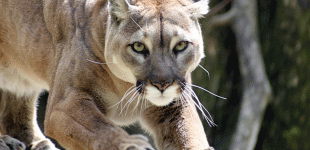 MOUNTAIN LION (Puma concolor)
MOUNTAIN LION (Puma concolor)
Known as the cat of one color, mountain lions are found throughout the United States. Mountain lions are North America’s largest feline. Studies completed in the 1990’s by Dr. Paul Beier concluded that mountain lions, also called cougars, were reaching Chino Hills State Park via a culvert beneath the 91 Riverside Freeway at Coal Canyon. Though sightings are rare in the State Park, if you see a cougar, DO NOT APPROACH IT AND DO NOT RUN! The Department of Fish and Game has published guidelines for how to handle mountain lion encounters.
Cougars tend have a solitary home range, where their territories do not overlap with other cougar home ranges. The average size of a cougar’s home range is approximately 100 square miles for males and between 20 and 60 square miles for females. In 2000, Coal Canyon, was permanently protected as a part of the State Park to ensure the cougar had room to roam through the Park and was not separated from the larger Santa Ana Mountains ecosystem, where there are thought to be between 30 and 40 cougars residing.
They are tan in color, have long tails, with black coloring on their ears. Their young have blue eyes, tan color and black spots. Bobcats have significantly shorter tails, pointed ears, and are much smaller — these are the most significant distinctions between the two species (which are often confused with one another). On average, mountain lions weigh about 120-150 pounds and can reach a length (from nose to tail tip) of eight feet. This species can run as fast as 43.5 miles per hour! Their strength and agility are incredible. In fact, a cougar has enough muscle strength to clear a ten foot fence with a deer in its mouth! Deer and other prey species, are the preferred food for the cougar.
 BOBCAT (Lynx Rufus)
BOBCAT (Lynx Rufus)
This member of the cat family (Felidae) ranges from northern Mexico to southern Canada and is common in much of the continental United States. The bobcat gets its name by its black stubby or “bobbed” tail. Its color can be from a gray to a brown coat with distinctive black bars on its forelegs. It is bigger than a house cat and smaller than a mountain lion. It is quite well adapted to wide variety of habitat types including woodlands, chaparral, swampland environments, and semi-desert. The bobcat, has even demonstrated the ability to adapt to human encroachment by living on the urban edge when towns and developments border open space.
Like many other wild feline species, such as the mountain lion, the bobcat has territories and will stay within their home range. They will mark their home range with urine and feces or they also can leave scratch marks on prominent trees. Their keen scent will then provide an immediate alarm if they approach another cat’s territory. This method of marking their territory and their response to other animals scent is one of the main reasons why Chino Hills State Park has such as strict policy concerning dogs. Dogs are not allowed on any of the trails and leashed dogs are only allowed on Bane Canyon Road. Bobcats are afraid of dogs and consider them a threat, because dogs mark their territory too and will cause the bobcats to relocate and perhaps abandon their home range. If bobcats leave the Park, this will upset the balance of nature and the population of other species.
Within the last few years there has been a concern with the bobcats residing in Chino Hills State Park. Some bobcats, have apparently lost their fear of humans and have wandered up to hikers. Though the bobcats are acting in a very non-threatening manner, Park staff believe these encounters are caused by some visitors offering the bobcats food in an attempt to get them closer. Please note that bobcats and ALL animals in the Park are to be treated as wild animals and should never be approached.
 COYOTES (Canis latrans)
COYOTES (Canis latrans)
Coyotes are found all throughout the Park. Their coat blends in well with the Park’s colors. Their camoflauge coloring is brown, while their bellies tend to be white. They tend to grow 30-34 inches in length (tail excluded) and stand about two feet tall at the shoulder.
These howling creatures tend to hunt in pairs and have a distinct howl after catching prey. They tend to congregate in packs of six, with the pack mostly consisting of adults and their young. Coyotes are normally nocturnal but can often been seen in the daylight in the Park.
Coyotes mostly live about 10 years in the wild and they hold monogamous relationships with their mate for several years. They are 90% carnivores focusing mainly on small mammals like rabbits and squirrels. They will also eat birds when they nest close to the ground. Coyotes have also adapted to the human environment. A coyote can generally cover 2.5 miles a night in search of food.
To reduce human interaction with coyotes, it is recommended to keep your own pet’s food and water indoors and your trash in a secure enclosure.
 MULE DEER (Odocoileus heminous)
MULE DEER (Odocoileus heminous)
This species is common through out the western United States and gets its name from its unusually large ears, which looks like a mule’s ears. Mule deer are often confused with black tailed deer and the biggest difference is the tail (which for a mule deer has a black tip) and antlers (which for the mule deer grow forked and not forward). It is always fun to see a mule deer move because instead of walking they tend to leap with all four legs in unison. With this gait they can reach speeds up to 45 miles per hour!
These deer have a dark grey and brown coloring, with small white patch at its rump. Its tail is drooped and not uplifted — another distinction from other deer species. They have sturdy legs and reach a height at the shoulder of roughly 3-3.5 feet, with a length of 4-6.5 feet. Males are larger than females and their color helps disguise them from predators such as cougars and coyotes. Like cows, deer have a multi-chambered stomach where food can sit for a while before it is digested. In the wild deer can live up to about 10 years, however in captivity it is 25 years.
Mule deer are herbivores and tend to prefer edge habitats. They eat shrubs, berries, and grasses and tend to be most active at dawn and dusk. They bed down during the day and use the shade of trees and the comfort of grasses to make their temporary quarters. It is not uncommon to see deer in the State Park, so keep your eye out on the hillsides.
 RACCOON (Procyon lotor)
RACCOON (Procyon lotor)
Its appearance is often compared to a masked bandit, raccoons are a medium sized mammal weighing in at about 8 – 20 pounds. They are usually nocturnal and are omnivorous eating bugs, plants, and other mammals. Raccoons are noted for their exceptional intelligence and are often viewed as mischievous.
They have a two very dexterous front paws and are highly adaptable. New research shows raccoons partake in gender specific social behavior. Their territories range from 7 acres – 20 square miles. Their life expectancy is between 1.8 and 3.1 years. The most common cause of death is hunting and traffic accidents.
Raccoons have been known to have adapted well to the urban environment. It is important to reduce the incentive of raccoons coming into urban environments. To reduce human interaction, it is recommended to keep your own pet’s food and water indoors and your trash in a secure enclosure.
 Opossums (Didelphis virginiana)
Opossums (Didelphis virginiana)
Spelled opossum, but pronounced possum, these critters make up the largest order of marsupials in the Western Hemisphere. Virginia Opossums are found north of Mexico and retain a flexible diet and reproductive strategy which makes them successful in a variety of habitats and conditions.
The largest opossum grows to be about the size of a house cat and spend quite a bit of time in trees (semi-arboreal) eating fruits and insects. Interestingly, opossums have a prehensile tail (though adults tails are not strong enough to hold their weight hanging from a tree) and females have a pouch (similar to a kangaroo). Their immune system is quite strong and they either have total immunity or partial immunity to the venom of rattle snakes.
These creatures tend to remain secluded and are nomadic. Though their first defensive is hissing one of the most well known defenses is to “play opossum” or play dead when they feel threatened. This loss of consciousness is regained in 40 minutes to 4 hours time.
They have poor eye sight and poor memories, but a full mouth of teeth. It is best to keep your distance from these, and all wild animals, as there is the potential to have the animal attempt to bite.
 STRIPED SKUNK (Mephitis mephitis)
STRIPED SKUNK (Mephitis mephitis)
The striped skunk is found over most of North America (north of Mexico) and is one of the most recognizable critters in the Park — both by sight and smell. The skunk has a black body with a white stripe and is generally the size of a house cat. They weigh in between six and eight pounds and are about 13-18 inches long.
Males tend to be a bit larger than the females. This animal has a well developed anal scent gland (what it is known for) that can emit a highly unpleasant odor. The striped skunk has only one main predator — the great horned owl which can’t smell the skunk’s odor so it has no fear of getting sprayed.
Like other Park animals, the skunk is crepuscular having most of it’s activity during dusk and dawn. The striped skunk has a varied diet and is considered omnivorous.
To reduce human interaction with skunks, it is recommended to keep your own pet’s food and water indoors and your trash in a secure enclosure.
 WESTERN GREY SQUIRREL (Sciuris griseus)
WESTERN GREY SQUIRREL (Sciuris griseus)
Chino Hills State Park also has small mammal species, like the western grey squirrel. This critter has a full fluffy tail that differentiates it from the chipmunk. Grey squirrels are tree squirrels found along the western coast of the U.S. This particular species undergoes a complete molt from head to toe in the spring — where its fur color adjusts to the season. This molt also takes place again the fall, but goes from rump to head and does not replace the tail fur.
Western grey squirrels are only about pound or so in weight and their length (including tail) ranges from about 17 inches to 23 inches. These squirrels mate from December to June and their young emerge between March and August. There are normally one to five babies in a litter. Their primary food is nuts and seeds and they are strictly diurnal, which means they are not active at night. One of their favored foods includes the acorns, which are quite common in the Park from the various oak trees. Typical squirrel behavior is to store a cache of nuts and acorns in a tree hollow or stump for later feeding. Though squirrels may approach you, do not approach them and do not feed them. Human diets are extremely different than a squirrels diet and our food can cause significant problems to squirrels, including death.
Though they are not a threatened species grey squirrels have declined in recent years due to urbanizations, loss of habitat, and catastrophic wildfire. Other problems this species has encountered is disease, which has hindered its numbers. Species like the fox and other ground dwellers are also out competing the squirrel for food and contributing to its decline.
